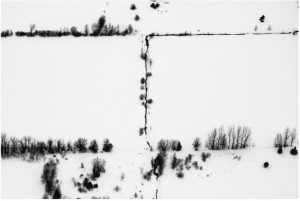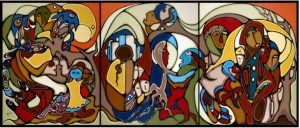As you continue to read and research the novel, you may find that it can be difficult to find scholarly resources about a text that was published so recently. In this section, we will explore ways to overcome that challenge by referring to critical conversations in and about Anishinaabe literature beyond Rice’s novel that can support our exploration of horror, in particular with reference to ecocriticism, Indigenous literary nationalisms, and genre studies.
Eco-Crises: Communities, Economies, Ecologies
Moon of the Crusted Snow’s invocation of fear and dread has been connected to real-world environmental crises. Reuben Martens’ article “Petromelancholia and the Energopolitical Violence of Settler Colonialism in Waubgeshig Rice’s Moon of the Crusted Snow” argues that the novel reflects trauma and grief at the loss of a “modern” way of life that he calls “petroculture,” in which communities come to depend on the lifestyle conveniences that are afforded by fossil fuels (199). The northern Anishinaabe community depicted in Rice’s novel straddles what could be considered two ways of life: the modern “petrocultural” lifestyle that relies on motor vehicles for access to life-giving resources (like mass-produced food products and heated shelter against the winter) and the more traditional practices that rely instead on the land itself. In Martens’ reading, the novel shows that these two lifestyles are deeply entangled. The novel’s tradition-minded protagonist Evan Whitesky, for instance, provides for his extended family by hunting moose on the land, albeit with the help of a gas-powered four-wheeler that allows him to traverse “vast amounts of open terrain and thick bush throughout the day” (6).

View of a Northern Ontario winter, marked by an eerie “break” in the landscape. “Ontario Winter 6307” by Amanda Graham is licensed under CC BY-NC-ND 2.0
As Rice depicts it, this fusion of so-called “modern” conveniences with ancestral land-based knowledge is less of a compromise than a necessary adaptation. Indeed, we can argue that one of the fundamental premises of Moon of the Crusted Snow is that the two ways of life—the “petrocultural” and the ancestral—are on equally precarious footing. In the context of Indigenous literary studies, this premise becomes especially provocative when we consider that Indigenous peoples and cultures have typically been represented (in the settler media, that is) as either already extinct or on the verge of extinction. Moon of the Crusted Snow flips the script, then, by dramatizing the abrupt end of “modern” life and forecasting the renewed vitality of “traditional” knowledges. Therein lies the potential for both fear and comfort, depending on the reader: where some audiences might find tangible comfort in the promise of a culturally-resurgent future for the Anishinaabe people, others who identify less with this possibility or find comfort in petrocultural lifestyles might find it threatening and outright horrifying.
Indigenous Scientific Literacies: Where Past and Future Blur Together
We should be very careful at the same time not to equate the terms “traditional” and “ancestral” with, for instance, “pre-modern” or “pre-scientific.” A crucial argument in Indigenous studies is that ancestral knowledges and practices are neither antithetical nor inferior to “modern” science and technology. Quite the contrary: these knowledges and practices are, by definition, a science in their own right. In her introduction to the pathclearing anthology Walking the Clouds (2012), the first anthology of Indigenous science fiction, Anishinaabe scholar Grace Dillon refers to the concept of “Indigenous scientific literacies,” which are “sustainable practices [that] constitute a science despite their lack of resemblance to taxonomic western systems of thought” (7). She writes that “[i]n contrast to the accelerating effect of techno-driven western scientific method, Indigenous scientific literacies represent practices used by Indigenous peoples over thousands of years to reenergize the natural environment while improving the interconnected relationships among all persons (animal, human, spirit, and even machine)” (7). Dillon’s point is that, while Indigenous scientific literacies are, if anything, a welcome alternative to Western scientific taxonomies, the former practices are by no means antiquated or atavistic; rather, as an alternative to the current norm, they are arguably more vital, viable, and sustainable.
Between Martens (who addresses the novel directly) and Dillon (who does not address the novel directly, but who nonetheless offers some useful context about Anishinaabe literature), we can begin to situate Moon of Crusted Snow according to two sides of a similar critical conversation. Martens brings the concept of “petroculture” into the conversation to describe the ways in which energy consumption and survival are intertwined in the novel. Dillon, meanwhile, introduces the concept of Indigenous (more specifically, Anishinaabe) scientific literacies, which we can then use to help understand Moon of the Crusted Snow’s references to (for instance) traditional Anishinaabe medicine. In the next subsection, we will touch upon how “petroculture” and “scientific literacies” reflect different visions of the past, present, and future for the Anishinaabe people in Rice’s imagining of the post-apocalypse and its horrors.
Anishinaabe Futures: The Work of Resurgence
While the apocalyptic crumbling of settler society lurks in the background of Moon of the Crusted Snow, it would be inaccurate to say that the novel is preoccupied only with this horror and the violent ending of a people. On the contrary, Rice’s novel is concerned just as much with the possibility of sustainable Indigenous futures (specifically, the future of the Anishinaabe people) through decolonization: the literal process of taking apart the ongoing structures of settler-colonialism. This interest in decolonial futures is in keeping with contemporary Anishinaabe scholarship, which often centers the concept of resurgence. Grace Dillon goes so far as to suggest that “all forms of Indigenous futurisms are narratives of biskaabiiyang, an Anishinaabemowin word connoting the process of “‘returning to ourselves’” (10). This act of returning “involves discovering how personally one is affected by colonization, discarding the emotional and psychological baggage carried from its impact, and recovering ancestral traditions in order to adapt in our post-Native Apocalypse world” (10). Notice again how in this declaration Dillon raises the point that, for Indigenous peoples, the apocalypse has already occurred and that everything that follows has been about recovering from that apocalypse. Auntie Aileen says as much in Rice’s novel: “Our world isn’t ending. It already ended. It ended when the Zhaagnaash [European settlers] came into our original home down south on that bay and took it from us. That was our world” (149).

“Roots” by Potawatomi (Anishinaabe) artist Daphne Odjig, 1979, Government of Ontario Art Collection, 625804. Licensed under CC BY-NC 2.0
We should also be clear that resurgence is not to be misunderstood as mere tokenism or atavism. Fellow Anishinaabe (Michi Saagig) author and theorist Leanne Betasamosake Simpson, who helped popularize the term “resurgence” in the 2010s, rejects thinking of resurgent practices as strictly or benignly “cultural.” In her book As We Have Always Done: Indigenous Freedom Through Radical Resistance, Simpson argues that “[c]ommunity-based resurgence projects . . . are inherently political and cultural because the intent is to facilitate radical transformation rather than just a cultural revitalization” (50). She emphasizes the term “radical” with reference to both grassroots revolutionary change and literal plant roots—radical in this sense means not to transform the land itself, but to transform relationships with the land. Simpson is rejecting one colonial set of frameworks in order to privilege an alternative framework: “an ethical and practical way” of living with the land derived from ancestral Anishinaabe customs. In Simpson’s work as well as in Rice’s Moon of the Crusted Snow, that “ethical and practical way” is specifically and uniquely Anishinaabe. Only with that in mind can we begin to appreciate how Rice’s novel engages with Anishinaabe knowledge in order to imagine a plausible and sustainable future—a future that may offer comfort to some readers and fear to others.
Extending Critical Frameworks: Questions to Consider
1. Working with Dillon’s concept of Indigenous scientific literacies and Simpson’s concept of resurgence, we might ask: how exactly does Rice depict the resurgence of Anishinaabe scientific literacies in Moon of the Crusted Snow? One place to look is in the novel’s recurring mentions of “the old medicine ways,” usually in connection with the character of Auntie Aileen, the eldest knowledge keeper in the community. Auntie Aileen expresses resurgent optimism, for instance, when she encourages Evan to take his wife Nicole “for a walk in the bush. When the spring comes, ask her to show you some medicines. She’ll know a lot now, if she remembers all the stuff from when I used to take her and all the young girls out there. It will be important if we don’t get any new supplies in from the hospital down south” (147).
- As Auntie Aileen explains it, the ones who are primarily responsible for Anishinaabe medicinal literacies are women and girls. How is gender reflected in the ways in which this knowledge is passed down between generations—at least according to the novel?
- How too does Auntie Aileen’s concern for Anishinaabe women’s knowledge measure against the roles that women like Nicole play in the rest of the novel?
2. “Medicine” in Moon of the Crusted Snow is not just herbs and remedies. Laughter is a key form of medicine in the community: “‘Sometimes all we got is laughter,’ Nicole said, echoing something her mother would say. ‘Around here we say it’s good medicine’” (161).
- Like horror itself, humour is not necessarily universal. Are there parts of Moon of the Crusted Snow that are depicted as being funny to the characters, but that you as a reader don’t find funny? What can we make of this difference in emotion?
- Conversely, are there moments in the novel that you find funny, but that are seen as scary or dangerous by the characters?
- In what ways does Rice give us the tools to understand the role that humour (and especially Anishinaabe-inflected humour, with which readers may or may not be familiar) plays as we experience the apocalypse alongside the novel’s characters?
Works Cited
- Dillon, Grace L. “Imagining Indigenous Futurisms.” Walking the Clouds: An Anthology of Indigenous Science Fiction, edited by Grace L. Dillon, U of Arizona P, 2012, pp. 1-12.
- Martens, Reuben. “Petromelancholia and the Energopolitical Violence of Settler Colonialism in Waubgeshig Rice’s Moon of the Crusted Snow.” American Imago, vol. 77, no. 1, 2020, pp. 193-211.
- Rice, Waubgeshig. Moon of the Crusted Snow. ECW, 2018.
- Simpson, Leanne Betasamosake. As We Have Always Done: Indigenous Freedom through Radical Resistance. U of Minnesota P, 2017.








 ©
©